
Yellowstone officials work to manage bison
The mention of the nation’s oldest and first official national park conjures images of mountainous terrain, Old Faithful geyser and an abundance—in fact an overabundance—of bison.
According to the National Parks Conservation Association based in Washington, D.C., Yellowstone is home to the largest wild, genetically pure herd of bison in the country. However, the plethora of bison can easily turn into a dangerous overabundance, a problem that has led to the calving of 600 to 800 bison every year from Yellowstone National Park, a park that occupies parts of Wyoming, Montana, and Idaho.
| Click on the video on the right to view a multimedia slideshow about bison management at Yellowstone National Park prepared by writer Jenna Johnson. |
Yellowstone can naturally accommodate between 5,500 to 7,500 bison during winter months based on food available. Because bison roam to areas of lower elevation during these months, migration puts them in direct competition with other animals and in conflict with agriculture and development.
The National Park Service predicts that without intentionally reducing the number of bison, the population could reach 6,000 by the end of 2016. The number of bison migrating to the northern boundary of Yellowstone would almost certainly skyrocket.
Bison that leave the park are currently managed by both Yellowstone and Montana’s Department of Livestock. In a recent court case, the state of Montana declared the status as to whether Yellowstone bison are considered wild or domestic as “ambiguous.”
“Bison have a dual designation, but when they come into Montana from Yellowstone Park, they really don’t fit the definition of livestock. They are treated as wildlife,” said Steve Merritt, public information officer for the state of Montana.
Because of this, landowners have no recourse to cover any damage caused by bison migration.
According to Pat Flowers, Region 3 supervisor for Montana Fish, Wildlife, and Parks, the bison can cause a significant amount of property damage, including destroying fencing, trees and even lawn furniture. They also cause great danger when they wander onto highways.
| At left, snowy bison at Yellowstone (Photo courtesy of NPS and Neal Herbert). Below, hazing bison into Yellowstone Park in winter 2008 (Photo Courtesy of The Buffalo Field Campaign). | 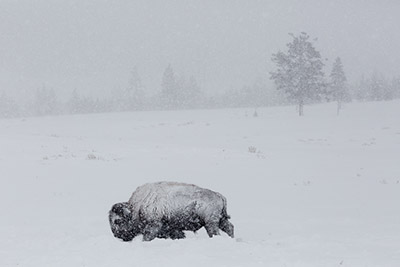 |
“We’ve had three collisions north of the park this year. The cars involved were totaled, although luckily no one was injured,” said Flowers.
For these reasons, the National Park Service and the state of Montana are both leaning towards embracing a “bison as livestock” mentality, meaning that the bison could be hunted outside the Greater Yellowstone Area.
Another threat of a high bison population is a disease called brucellosis, which induces abortions in buffalo, cattle and elk. It was first discovered in the Yellowstone bison herd in 1917, although bison are naturally immune to the effects of the disease.
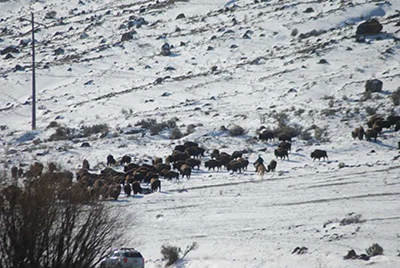 Despite this immunity, bison that test positive for brucellosis antibodies in a blood sample are still sent to slaughter, as they could potentially infect other cattle.
Despite this immunity, bison that test positive for brucellosis antibodies in a blood sample are still sent to slaughter, as they could potentially infect other cattle.
Culture samples then determine if the bison sent to slaughter are actually infected. While 60% of bison test positive to exposure, studies have determined that only between 2 percent to 20 percent of bison carry the brucellosis bacteria.
According to the National Park Service, culling of bison is due to the “real and perceived threat” of bison spreading the disease to cattle within the park. However, there has never been a documented case of wild buffalo infecting cattle with the disease.
“Transmission doesn’t occur because lots of time and money goes into keeping it from happening,” said Dr. Jack Ryan, animal welfare representative for the western region of the Animal and Plant Heath Inspection Service. “It’s still a very real risk.”
Some point to the fact that elk are also at risk for transmitting brucellosis, and question why they are not regulated in the same way as bison. There have been 19 documented cases of brucellosis transmission from elk to cattle since 2001.
“The risk of transmission exists in both species but we’ve been more successful mitigating the risk in bison because they are easier to contain than elk,” said Dr. Marty Zaluski, state veterinarian for the Montana Dept. of Livestock.
Ryan explained that the controversial bison management program is a precautionary measure.
“The infection is spreading from the elk and exposes more cattle and ranched bison herds. While the bison haven’t directly been involved in that transmission, they are unfortunately a part of the reservoir in which it occurs,” said Ryan.
The exact process by which bison are removed from the park is one that remains a bone of contention between park rangers and animal rights activists.
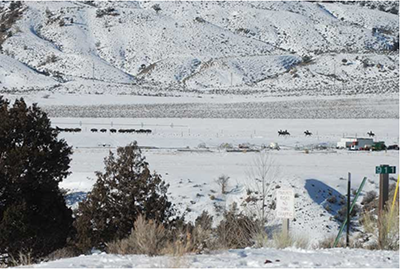 |
At left, hazing bison into Yellowstone National Park (Photo courtesy of the Buffalo Field Campaign). Next, a bison calf (Photo courtesy of NPS and Jim Peaco). Below last, buffalo in Hayden Valley (Photo courtesy of NPS and Mary Meagher). |
Natural processes such as starvation and predation usually cannot deplete the bison population by the desired amount. Predation has a minimal effect; predators such as wolves, coyotes, bears and mountain lions typically prey on elk instead of large herds of bison that are difficult to attack.
Congressional laws prohibit hunting inside Yellowstone. Hunting outside the park boundaries by individuals with permits remains the primary means to remove bison, although it effectively accounts for the removal of only a few hundred bison a year.
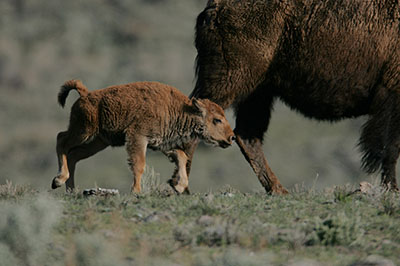 The court-mandated Interagency Bison Management Plan now calls for the removal of 25 to 50 bison per week for a month at the beginning of each year. After that, 200 to 300 females are shipped to slaughter, as female bison are more at risk for spreading disease.
The court-mandated Interagency Bison Management Plan now calls for the removal of 25 to 50 bison per week for a month at the beginning of each year. After that, 200 to 300 females are shipped to slaughter, as female bison are more at risk for spreading disease.
“When hunting doesn’t meet our goals, and when bison move towards northern boundary, we may choose to capture them. They may then be transported to tribal entities that may elect to send them to slaughter,” said Al Nash, public relations spokesperson for Yellowstone National Park.
This winter, 646 bison were slaughtered, rounding out a total count of 7,835 since 1985.
Many organizations, such as The Buffalo Field Campaign, dislike that the bison are being shipped to slaughter. They suggest other methods such as letting bison roam freely or shipping them to quarantine or research facilities.
However, by state and federal law, Yellowstone National Park is not permitted to transport live bison to other landscapes except under research permits.
“We have been working with a variety of groups to establish more facilities for bison management in the future, but those do not exist right now,” said Nash. “There is currently one research facility near the park, the U.S. Dept. of Agriculture Animal and Plant Health Inspection Service (APHIS).”
In a feasibility study, APHIS demonstrated that quarantine was an effective way to ensure that bison were not infected, and transfer them to Indian tribes. Unfortunately, when the study ended, so did the funding.
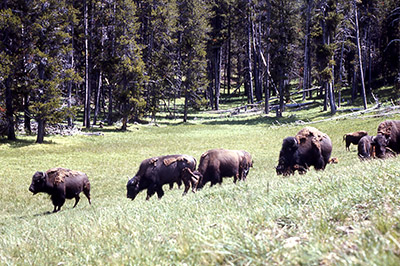 Currently, no operational terminal pastures or quarantine facilities exist in which bison would be repeatedly tested for brucellosis.
Currently, no operational terminal pastures or quarantine facilities exist in which bison would be repeatedly tested for brucellosis.
Zaluski said he felt there were possibilities for both types of facilities in the future, but they presently face several drawbacks. Animals in terminal pastures would have to be spayed or neutered before they could be permitted. Quarantines also involve rigorous protocol policies that need maintained.
However, there is hope. There is now some push for quarantine-like facilities, particularly from within Yellowstone.
“They liked the idea that it could happen,” said Ryan. “I wouldn’t be surprised in the future if some agencies got together and made a quarantine.”
In the future, organizations like The Buffalo Field Campaign may interact with the government in order to establish alternative solutions for the bison situation. Until then, despite the controversy, the Interagency Bison Management Plan will continue to determine Yellowstone’s bison population.

Comments are Closed